- Analysis
- Politics
- Federal
- Royal family
Thorpe’s cry of outrage at King echoes a long history of frustration
By Tony Wright
Indigenous Australia has long experienced the frustration of trying to deliver its cries of pain and outrage to the royal family.
Just ask the family of the late Aboriginal activist, Yorta Yorta man William Cooper.
In 1933, Cooper and fellow members of the Australian Aborigines’ League began gathering signatures for a petition to be sent to King George V, asking him, among other things, to intervene to prevent the genocide of “the Aboriginal race” and to grant Indigenous people a voice in parliament.
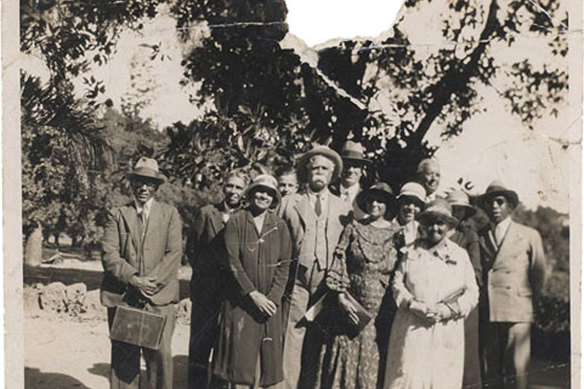
William Cooper (centre) with the founding members of the Australian Aborigines’ League at the opening in Northcote, around 1934.Credit: Koori Heritage Trust
It took several years to gather more than 1800 signatures from Indigenous communities strung out across Australia.
In 1937, Cooper, aged in his 70s, finally sent the petition to then-prime minister Joseph Lyons with the polite request that he forward it to the King, George VI.
It asked that the King act “to prevent the extinction of the Aboriginal race; to secure better living conditions for all; and to afford Aboriginal representation in parliament”.
Lyons’ cabinet took its leisurely time to consider the request.
And then, in 1938, it turned it down.
The cabinet ministers chose to take no action, they said, because parliament did not have the power to make a law for Aboriginal representation under the Constitution.
“No good purpose would be gained by submitting the petition to His Majesty the King,” Lyons’ ministers declared.
It took 77 years for one of Cooper’s grandsons, Uncle “Boydie” Turner, to arrange for a copy of the petition to be delivered to Buckingham Palace. It was handed to Queen Elizabeth II – George VI’s daughter – in 2014 by the then-governor general Sir Peter Cosgrove, at a ceremony in Scotland.
No one expected the Queen to respond publicly, and she never did.
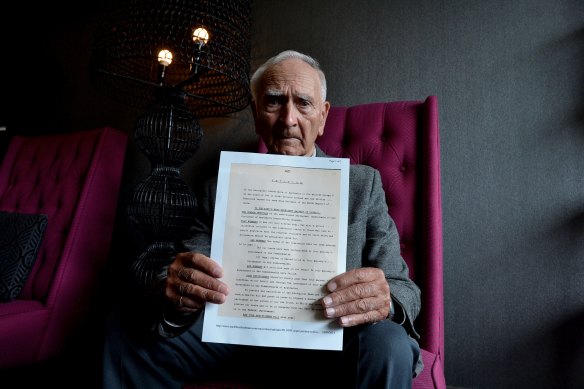
Uncle “Boydie” Turner with his grandfather’s petition.Credit: Justin McManus
She had, however, already been on a long and slow trajectory of trying to learn of the tribulations facing Aboriginal Australia.
Those efforts were not helped when, on her first visit to Australia in 1954, organisers erected screens so she could not see the humpies in which Aboriginal people lived on The Flat at Mooroopna, near Shepparton, as her motorcade drove by.
Aboriginal activists increasingly tried to win the Queen’s attention over the following decades.
Yet in 1970, when she attended events to mark 200 years since Captain Cook arrived on Australia’s east coast, she seemed publicly unmoved even as First Nations people protested by throwing wreaths into the sea as a re-enactment of the landing took place at Botany Bay. Actors dressed as Cook’s soldiers fired guns at other actors representing Aboriginal people. The Queen sailed off serenely in her yacht, the Britannia.
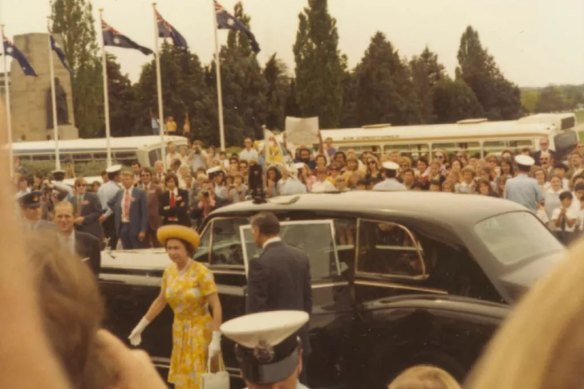
The Queen as greeted by well-wishers and protesters at the old parliament house in 1973. Credit: MOAD collection
In 1973, the Queen was jeered by protesters as she arrived at old Parliament House, and representatives of the Aboriginal Tent Embassy across the road handed Prince Philip, her consort, a list of demands, including Indigenous sovereignty.
Four years later, at a reception in Hobart, Tasmanian Aboriginal activist Michael Mansell handed the Queen a petition calling for Aboriginal land rights. She listened as he spoke of Tasmania’s Aboriginal people being dispossessed by the Crown she now represented.
As the protests and number of petitions grew, the Queen’s attention appeared to sharpen, according to a 2022 retrospective by Dan Butler on SBS/NITV.
By 1986, she was quoted in Australia’s newspapers declaring she was encouraged by the increased attention that was being given to the “history and needs” of Aboriginal people.
Prince Charles – now King – represented his mother when he attended Sydney’s Australia Day celebrations of the First Fleet’s landing in 1988, where protests at the invasion could not be ignored.
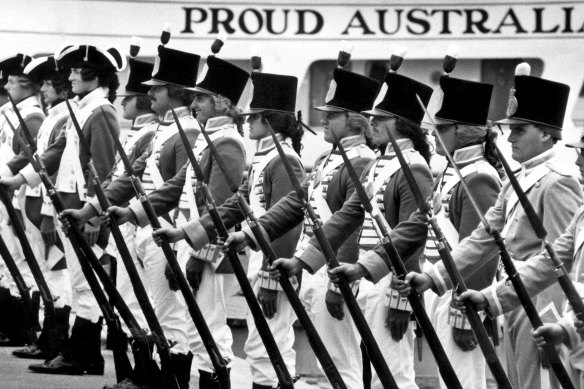
Troopers on guard when Prince Charles and Princess Diana visited for the bicentenary celebrations. Credit: Fairfax Photographic
To hammer home Indigenous Australia’s view, Woiworrung and Yorta Yorta man Burnum Burnum took his own Australia Day message all the way to England.
As Sydney – and much of Australia – celebrated and protested on January 26, 1988, Burnum raised the Aboriginal flag beneath the white cliffs of Dover and claimed England on behalf of Aboriginal Australia.

Burnum Burnum plants the Aboriginal flag in the sand beneath the white cliffs of Dover in 1988.Credit: PA Images via Getty Images
The Queen’s efforts to understand and listen to Indigenous Australians eventually peaked in 1999, when she met a delegation of senior Aboriginal figures at Buckingham Palace.
It was the first audience granted by a monarch to First Nations representatives since 1793, when King George III met Bennelong, a senior man of the Eora people of the Port Jackson area, just five years after the First Fleet sailed into Sydney Cove.
Queen Elizabeth’s extended discussion with Aboriginal leaders Patrick Dodson, Peter Yu, Dr Lowitja O’Donoghue, Gatjil Djerrkura and Professor Marcia Langton was considered a significant breakthrough at a time when Australia was debating becoming a republic.
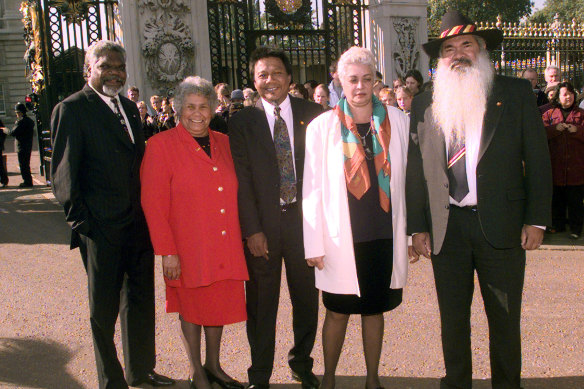
Left to right: Gatjil Djerrkura, Dr Lowitja O’Donoghue, Peter Yu, Professor Marcia Langton and Patrick Dodson stand in front of Buckingham Palace on October 13, 1999, after meeting Queen Elizabeth II. Credit: AP
Reports that the delegation would ask for an apology from the Crown were not realised, but the discussion was said to have touched on reconciliation and the continuing pain the British invasion had caused Indigenous communities.
Dodson was quoted as describing the meeting as “extraordinarily beneficial”. The Queen had proved interested in the discussion and had asked many questions, he said. Dodson added that it was “a quite significant difference to the way we’re treated sometimes in our own country” by then-prime minister John Howard.
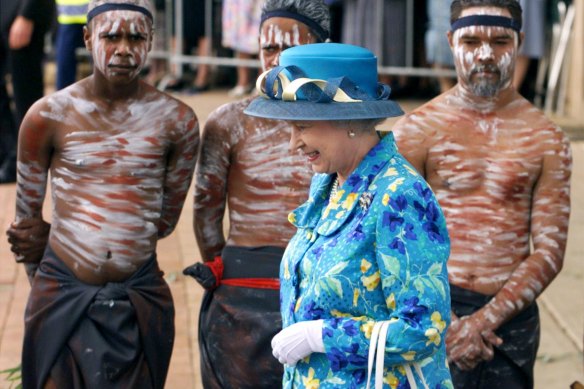
Queen Elizabeth walks past traditional Aboriginal dancers after visiting a radio station in the outback town of Bourke. Credit: Reuters
By 2000 – during the Queen’s 13th official visit to Australia – she insisted on including the troubled NSW town of Bourke on her itinerary.
Having visited Bourke Primary School, where Aboriginal culture was taught to help heal rifts between Indigenous and white communities, and an Indigenous radio station was operating to ensure the survival of a local language, the Queen declared that “all communities need building with patience and understanding in ways such as these”.
More than 20 years later, however, with a new king visiting Australia, large sections of Aboriginal Australia remain anguished by the toll on their communities more than two centuries after an invasion in the name of a British monarch. The Indigenous hope of a dedicated Voice to parliament – something William Cooper requested almost 70 years ago – has lately been denied by referendum.
And now an Indigenous senator, who opposed the Voice, roars her own views at the King in Australia’s Parliament House.
Cut through the noise of federal politics with news, views and expert analysis. Subscribers can sign up to our weekly Inside Politics newsletter.